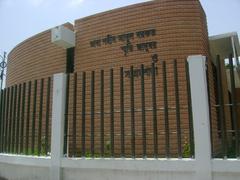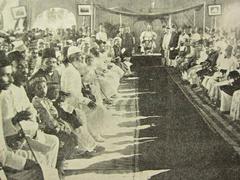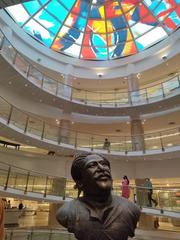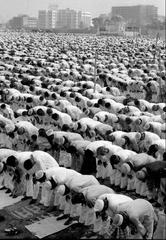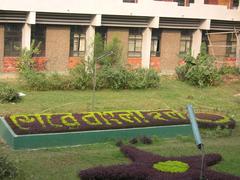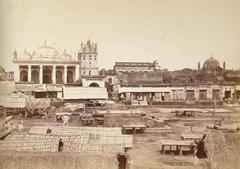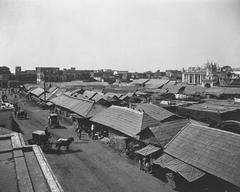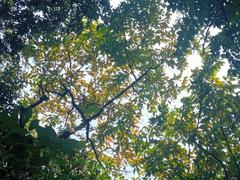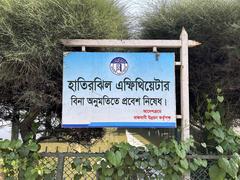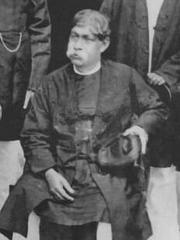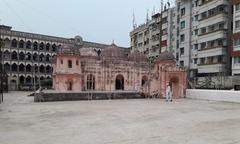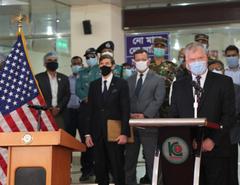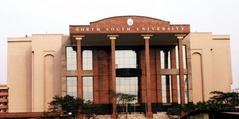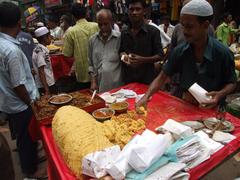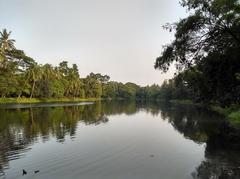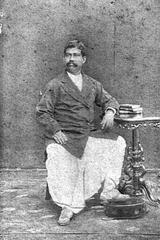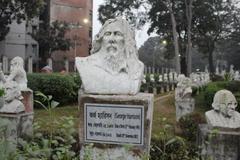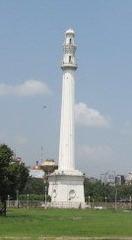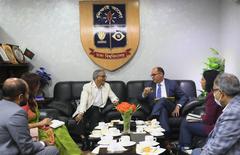
Star Mosque Dhaka: Visiting Hours, Tickets, and Travel Guide
Date: 04/07/2025
Introduction
Nestled in the vibrant heart of Old Dhaka, the Star Mosque—locally known as Tara Masjid—is one of Bangladesh’s most treasured historical and architectural landmarks. Famed for its iconic star-patterned Chinitikri mosaics, the mosque captivates visitors with its blend of spiritual ambiance and intricate artistry. Built in the early 19th century by Mirza Golam Pir, the mosque underwent significant transformation in 1926 under Ali Jan Bepari, who expanded its Mughal-inspired architecture and infused it with elaborate star motifs and floral patterns. Today, it remains an active center of worship and a celebrated example of Dhaka’s rich cultural and religious tapestry (nijhoom.com; Wikipedia; hollymelody.com).
This guide details the Star Mosque’s history, architecture, visiting hours, ticketing, accessibility, conservation efforts, and nearby attractions—equipping you to plan a respectful, enriching visit to this iconic site. For additional tips and local insights, consult official resources and local guides (Orient Eco Tourism; Medium; travelsetu.com; ruchiexplorelimitless.com).
Table of Contents
- Introduction
- Historical Background and Architectural Evolution
- Visiting Information
- Preservation and Conservation
- Sustainable Tourism and Visitor Guidelines
- Frequently Asked Questions (FAQ)
- Summary and Practical Tips
- References
Historical Background and Architectural Evolution
Origins and Early Construction
The Star Mosque’s roots trace to the first half of the 19th century, attributed to Mirza Golam Pir, a notable zamindar in Dhaka. The original mosque, dating between 1819 and 1832, featured a modest rectangular Mughal-style structure with three domes and four corner towers—emphasizing simplicity and devotion (nijhoom.com; Wikipedia; hollymelody.com).
Major Renovations and Transformation
A pivotal transformation occurred in 1926, financed by Ali Jan Bepari. This renovation expanded the mosque with a five-arched eastern verandah, increased the number of domes from three to five, and introduced the signature Chinitikri mosaic—embedding broken porcelain and glass to create elaborate star and floral motifs (nijhoom.com; Wikipedia).
Key decorative features include:
- Hundreds of blue star motifs across domes and walls
- Hexagonal mosaics and floral designs merging Islamic, Persian, and regional art
- A unique Mount Fuji motif, reflecting Japanese influence
- Crescent-and-star patterns on the façade
The interior is adorned with mosaic tiles, terracotta decorations, and chandeliers that amplify its serene ambiance. In 1987, the Ministry of Religious Affairs extended the prayer hall and added two more domes, finalizing the five-dome silhouette (Wikipedia; nijhoom.com).
Architectural Style and Influences
Star Mosque fuses Mughal, Persian, Bengali, Chinese, Japanese, and European influences. Its Chinitikri mosaics, imported porcelain tiles, and symbolic star motifs highlight the mosque’s cosmopolitan heritage and the region’s legacy as a crossroads of art and trade (oriobd.com).
Visiting Information
Hours and Tickets
- Visiting Hours: Daily, 8:00 AM–7:00 PM (tourists should avoid prayer times, especially Fridays and Ramadan)
- Entry: Free for all visitors; donations for maintenance are welcomed (Orient Eco Tourism; hollymelody.com).
Getting There
Located on Abul Khairat Road in Armanitola, Old Dhaka, the mosque is easily accessible by rickshaw, taxi, or public transport. Rickshaw is the preferred option due to narrow, bustling streets. GPS coordinates: 23°42’56.36”N, 90°24’6.01”E (ruchiexplorelimitless.com; alonelytraveler.com).
Accessibility
The historic setting and entrance steps may present challenges for those with mobility impairments. There are no dedicated wheelchair facilities, but local guides or companions can help navigate the area.
Tours and Photography
Local guides offer informative tours describing the mosque’s history and mosaics. Photography is permitted but should be conducted respectfully—avoid flash and photographing worshippers without consent.
Nearby Attractions
- Ahsan Manzil (Pink Palace)
- Lalbagh Fort
- Dhakeshwari Temple
- Kartalab Khan Mosque
- Old Dhaka’s markets and food stalls
These sites showcase the broader historical and cultural richness of Old Dhaka (travelsetu.com).
Preservation and Conservation
The Star Mosque is a protected monument under Bangladesh’s Department of Archaeology. Ongoing restoration ensures preservation of the delicate Chinitikri mosaics and structural integrity. Conservation faces challenges from urban congestion, environmental factors, and funding limitations—making community support and responsible tourism vital (hollymelody.com; Medium).
Sustainable Tourism and Visitor Guidelines
To balance the mosque’s sacred function with tourism:
- Dress modestly: Men and women should cover arms and legs; women should cover their hair with a scarf
- Remove shoes before entering the prayer hall
- Silence: Maintain a quiet, respectful demeanor
- Photography: Seek permission before photographing people or interiors
- Visit outside prayer times unless accompanied by a guide or invited
- Support local businesses and contribute to the local economy through tours, dining, and handicraft purchases (bluemosque.net; travelsetu.com).
Frequently Asked Questions (FAQ)
Q: What are the Star Mosque visiting hours?
A: Daily, 8:00 AM–7:00 PM (avoid prayer times for non-worshippers).
Q: Is there an entry fee?
A: No, entry is free; donations are appreciated.
Q: Are guided tours available?
A: Yes, local guides are available nearby and through tour operators.
Q: Is the mosque wheelchair accessible?
A: Accessibility is limited due to historic structure and narrow lanes.
Q: Can non-Muslims visit?
A: Yes, but visitors must respect customs and avoid disrupting prayers.
Summary and Practical Tips
The Star Mosque (Tara Masjid) remains a luminous jewel in Dhaka’s cultural and religious landscape. Its captivating Chinitikri mosaics and Mughal-inspired domes reflect a blend of local and international artistic traditions. Visitors benefit from free admission and generous visiting hours, with respectful guidelines ensuring the mosque’s spiritual sanctity and a welcoming atmosphere. Combine your visit with nearby sites—Ahsan Manzil, Lalbagh Fort, Dhakeshwari Temple—for a comprehensive heritage experience.
To stay updated on hours, tours, and events, download the Audiala app and explore related articles on Dhaka’s historical sites. Your visit contributes to ongoing conservation and the celebration of Bangladesh’s enduring heritage.
References and Further Reading
- Star Mosque Dhaka: History, Visiting Hours, Tickets & Travel Guide, 2025, Nijhoom
- Star Mosque, Wikipedia
- Star Mosque Tara Masjid BD: Interesting Facts, History & Travel Guide, Hollymelody
- Star Mosque Tara Masjid, Oriobd
- Star Mosque, Orient Eco Tourism
- Dhaka The City of Mosques, Medium
- Star Mosque Tara Masjid Tourism History, Travelsetu
- Star Mosque, Ruchiexplorelimitless
- Star Mosque, Alonelytraveler
- How to Dress Appropriately When Visiting Mosques, Bluemosque.net





